最新中职英语基础模块上册Unit 4 Speaking教案
- 格式:doc
- 大小:38.50 KB
- 文档页数:5
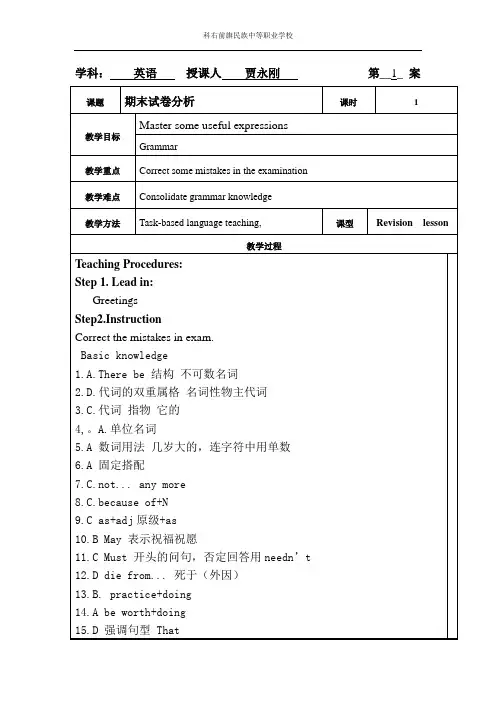
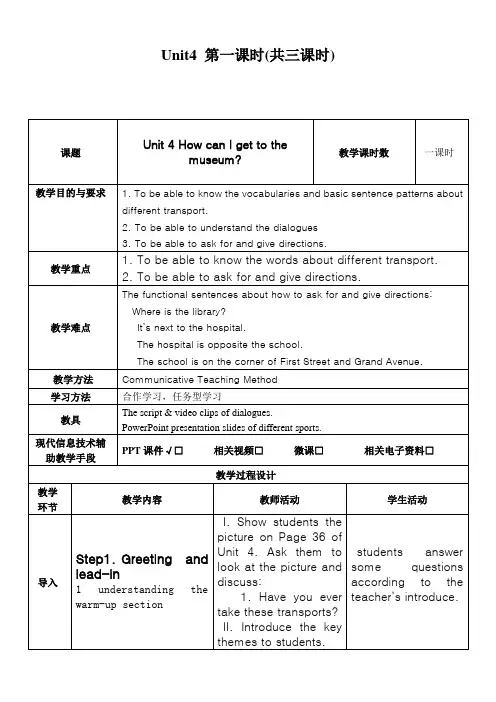
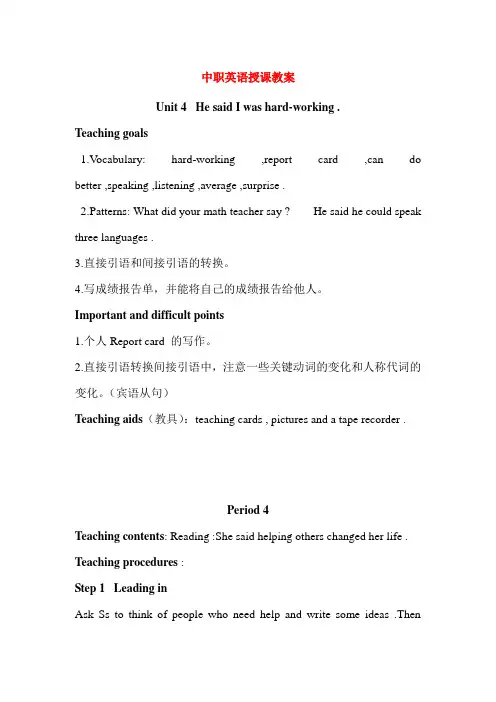
中职英语授课教案Unit 4 He said I was hard-working .Teaching goals1.V ocabulary: hard-working ,report card ,can do better ,speaking ,listening ,average ,surprise .2.Patterns: What did your math teacher say ? He said he could speak three languages .3.直接引语和间接引语的转换。
4.写成绩报告单,并能将自己的成绩报告给他人。
Important and difficult points1.个人Report card 的写作。
2.直接引语转换间接引语中,注意一些关键动词的变化和人称代词的变化。
(宾语从句)Teaching aids(教具):teaching cards , pictures and a tape recorder .Period 4Teaching contents: Reading :She said helping others changed her life . Teaching procedures :Step 1 Leading inAsk Ss to think of people who need help and write some ideas .Thendiscuss with their partner .Step 2 SB Page 32 , Section 2 .1.Have Ss read the passage first for meaning .2.Ask Ss to read it again and fill in the blanks .3.Check the answers .Step 31.SB Page 33 , Section 3 , 3a .(1).Ask Ss to read through again to find the relevant information for Yang Lei’s students .(2).Ask Ss to complete the information under “you” , saying what is true for their own lives .(3).Have Ss discuss their answers with their partner .2.SB Page 33 , Section 3 , 3b . In pairs ,ask and answer the questions .3.SB Page 33 , Section 3 , 3c .Have Ss write a summary of the reading and share the summaries in groups of five .Step 4 SB Page 33 , Section 4 .1.Have a class discussion about the work each organization does .2.Ask some Ss to say which organization they would like to work for and why .Step 5 HomeworkWrite the summary of the reading on their exercise books .教学反思:Period 5一. 单项选择。
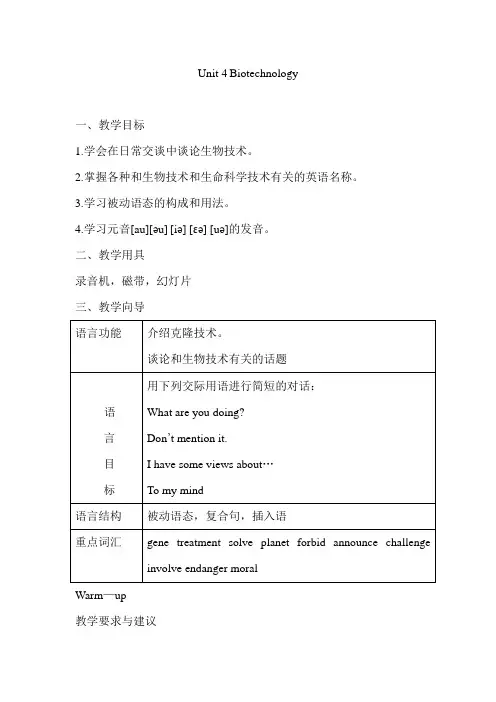
Unit 4Biotechnology一、教学目标1.学会在日常交谈中谈论生物技术。
2.掌握各种和生物技术和生命科学技术有关的英语名称。
3.学习被动语态的构成和用法。
4.学习元音[au][əu][iə] [ɛə] [uə]的发音。
二、教学用具录音机,磁带,幻灯片三、教学向导Warm—up教学要求与建议1.课前让学生预习生词和课文,课上可检查预习情况。
2.课上用幻灯片引导学生完成配图。
3.分组完成课文中的提问。
参考答案plete the dialogues.doing good Make believe safe deliciousPronunciation Practice带领学生练习元音[au][əu][iə] [ɛə] [uə],列举含有这些元音发音的单词,对比它们发音的不同。
Listening and Speaking一、教学重点二、教学建议1. 根据课文的听力材料练习对话。
2. 进行听力练习,填空。
3. 角色扮演(Role Play)(1)明确口语活动的任务,要求学生仔细阅读对话。
必要时可做简单的对话示范。
(2)学生成对活动,交换角色练习对话。
(3)教师掌握学生练习情况,解答学生提出的问题。
(4)教师和学生模拟B1对话,示范引导学生。
(5)总结学生的表现,及时纠正学生练习中的错误之处。
三、练习参考答案A2. Listen and fill the blankslike stations produce working electricity usedB2. Answer the questions(1) Yes (2) Yes (3) No3. Complete the following sentences(1) create (2) something (3) production (4) hazard (5) make use4. 略5. Listen to the dialogue and answer the questionssupplies grow twenty billion pressure tool听力原文A2. Listen and fill in the blanks.Some scientists are trying to get plants, or biological cells that act like plants, to work as small photosynthetic (光合作用的) power stations. For example, a scientist is working with green algae(水藻). He is trying to make them produce hydrogen(氢) instead of sugars during photosynthesis. Once the researchers can get the algae working efficiently, the hydrogen that they produce could be used to power fuel cells in cars or to produce electricity.B5. Listen to the dialogue and complete the form below.The scientists warn that the kinds of rice plants now have reached the limit of their supplies. Yet world rice production must grow by 30 percent in the next twenty years to meet demand. By 2025, as many as 4.6 billion people will depend on rice for survival. There is a lot of pressure on farmers to improve the crop. So the research of the rice genes is a valuable tool to solve crop risk.Language Bank带领学生练习记忆这些日常口语,并让学生课下反复练习,定时抽查。
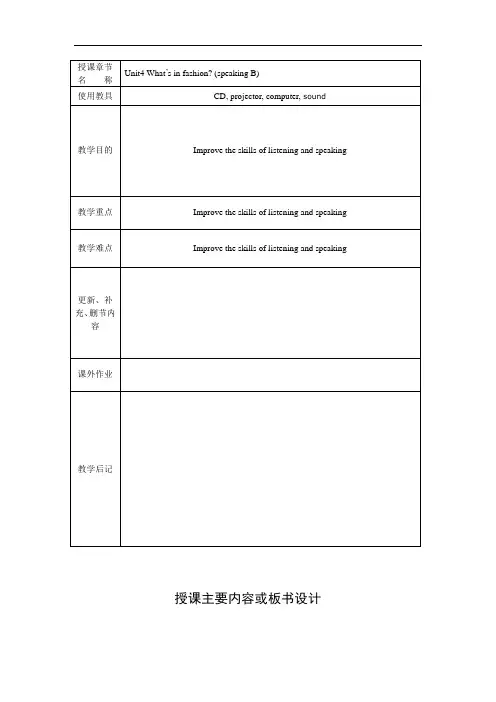
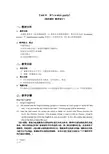
Unit 4 It’s a nice party!(第四课时教学设计)一、教材分析1.教学内容本课时系教材《英语基础教程1》第四单元的第四课时,教学内容包括V ocabulary practice 和Supplementary reading两部分,具体内容为:词汇练习和拓展阅读。
2.教学重点、难点⑴教学重点对本单元重点词汇、短语的理解和正确使用;对阅读文段的学习和理解;⑵教学难点对文段的理解性学习;二、教学目标1.知识目标⑴掌握本单元关于天气、与聚会相关的词汇、短语;⑵理解、读懂阅读文段;2.能力目标⑴学生能较灵活地使用关于聚会、天气的词汇、短语;⑵能根据要求从文段获取相关信息;3.情感目标学生能初步认识美国的派对种类,并认识到派对等社交活动对个人工作、生活的重要性;三、教学步骤Step One Lead in1.Group Competition(1)The teacher asks the English learning groups (4-5 students in every group) to finish the firsttask. “Can you read the key words in this unit? ” Several groups will be eliminated.(2)After the first round, six groups are asked to finish the second task.“Please translate thewords into Chinese/ English.” For example, Group A read a word in Chinese, Group B should translate the word into English as soon as possible. At last, the teacher and students choose the best group in this step.(设计意图:采取小组竞赛的方式帮助学生复习本单元单词,教师可先要求每组学生齐读单词,师生共同选出在第一轮朗读环节中的优胜小组;第二轮安排翻译任务,但是考官不是教师,而是采用A组出题B组快速回答的方式,能提高学生的参与兴趣。
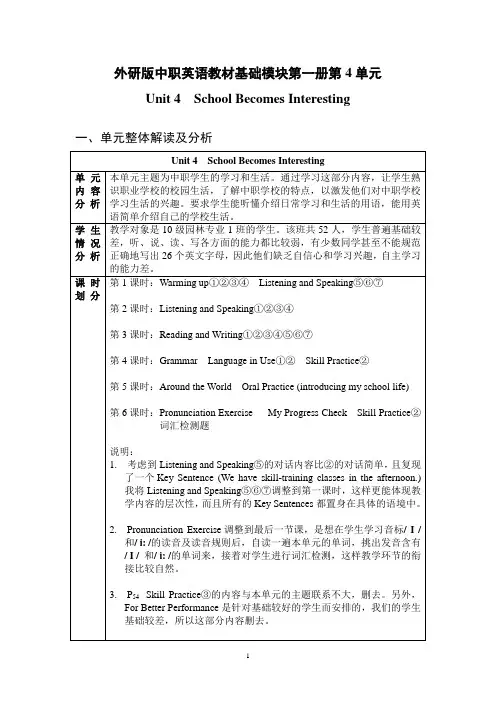
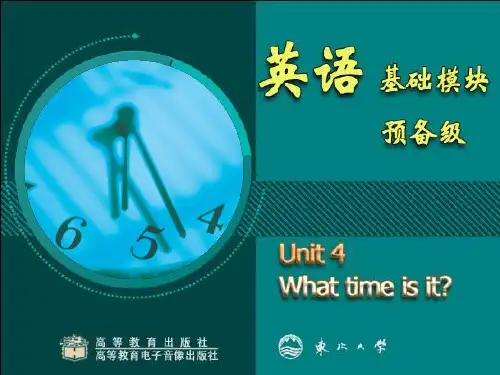
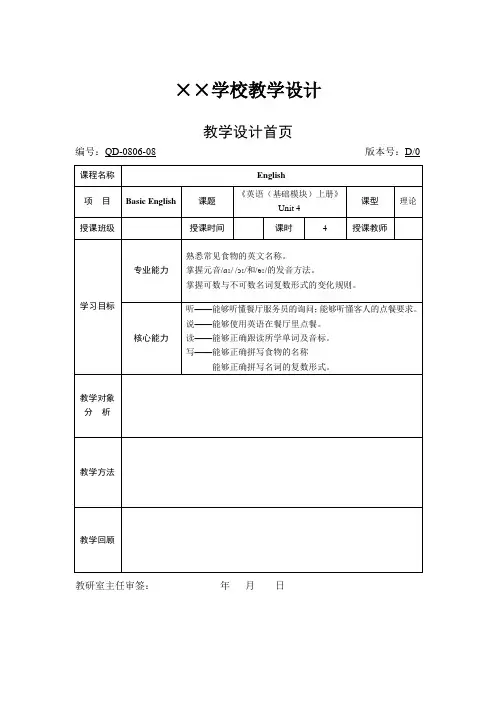
××学校教学设计编号:QD-0806-08教学设计首页版本号:D/0课程名称 项 目 Basic English 授课班级课题 授课时间English《英语(基础模块)上册》 Unit 4课型理论课时4授课教师学习目标专业能力 核心能力熟悉常见食物的英文名称。
掌握元音/ɑː/ /ɔː/和/əː/的发音方法。
掌握可数与不可数名词复数形式的变化规则。
听——能够听懂餐厅服务员的询问;能够听懂客人的点餐要求。
说——能够使用英语在餐厅里点餐。
读——能够正确跟读所学单词及音标。
写——能够正确拼写食物的名称能够正确拼写名词的复数形式。
教学对象 分析教学方法教学回顾教研室主任审签:年月 日教学环节 及时间分配教学设计内页教学过程(教学内容和教学方法)Unit 4 Milk or coffee?Ⅰ. Warm up (Activities 1-3)【目的】本活动的目的是先引入常见食物的英文名称,为下面的听说活动 做准备。
Activity 1 Look at the picture of foods. Write their names under each picture. Words given below may help you.【操作】步骤一:全班活动,教师展示图片,挑选不同的学生说出各个图片分别指的哪种食物。
步骤二:个人活动,教师匹配食物单词和图片,并对学生的回答作出反馈。
第【说明】本活动旨在引入主题,让学生了解各种常见食物的英文名称,利一用形象的图片能够帮助记忆。
课Activity 2 Read and tick.时 【操作】步骤一:全班活动,教师挑选不同的学生,挑出与餐厅相关的单词。
步骤二:全班活动,教师对各个单词进行讲解,并对学生的回答作出反馈。
【说明】本活动旨在深入主题,引出与餐厅相关的词汇。
与餐厅相关的词汇非常多,包括食物种类、餐具、相关人员的称谓及其他,教师可补充一些常见餐厅词汇,并扩展相应英语表达,参见下表:dessert 甜品fried rice 炒饭pudding 布丁specialty 招牌菜Food 食物soupdrinks/beverages汤饮料porridge 粥chicken and duck 鸡鸭main course 主菜appetizers 头盘,开胃菜chef’s special today’s special主厨特餐今日特餐fish and prawn 鱼虾pie 馅饼side dishes 配菜,副菜cutlet 肉饼教学环节 及时间分配教学设计内页教学过程(教学内容和教学方法)paper towel 纸巾 napkin 餐巾 knife 餐刀tip 小费 hostess 领座员Tableware 餐具coffee cup 咖啡杯coffee pot 咖啡壶platesaucer盘小碟子fruit plate 水果盘tray 托盘Others 其他wine list 酒类菜单front waiter 前台服务生apprentice 实习工service charge 服务费table cloth 桌布soup spoon 汤匙 mug马克杯captain 餐厅领班chef 厨师长Activity 3 Look and complete.【操作】第步骤一:个人活动,学生用上题中的适当单词补全对话。
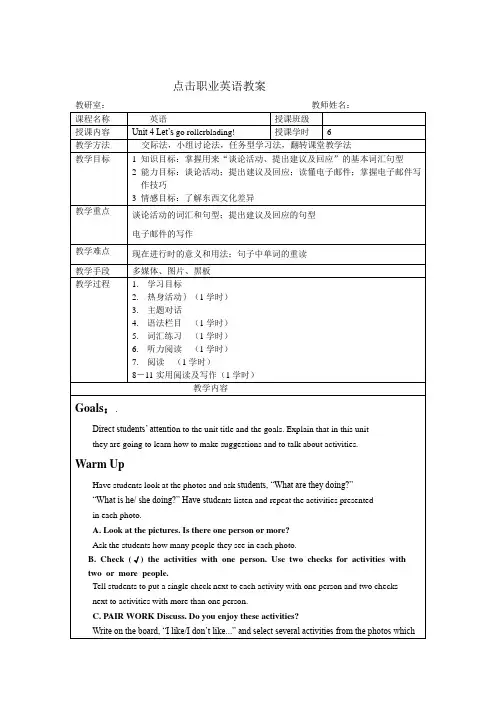
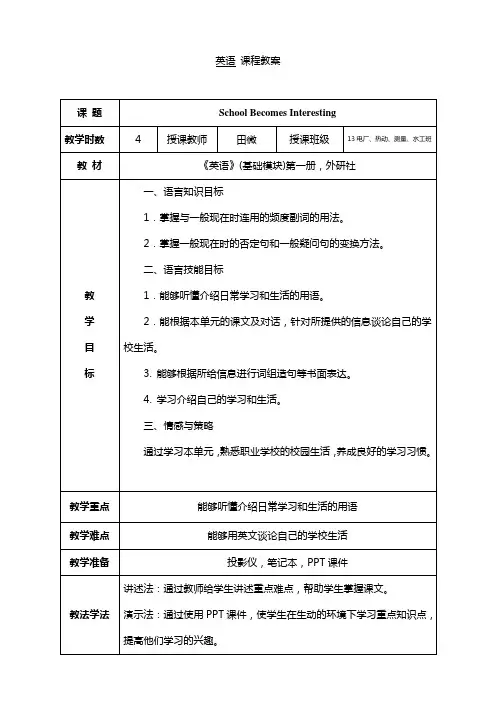
英语课程教案课题School Becomes Interesting教学时数 4 授课教师田微授课班级13电厂、热动、测量、水工班教材《英语》(基础模块)第一册,外研社教学目标一、语言知识目标1.掌握与一般现在时连用的频度副词的用法。
2.掌握一般现在时的否定句和一般疑问句的变换方法。
二、语言技能目标1.能够听懂介绍日常学习和生活的用语。
2.能根据本单元的课文及对话,针对所提供的信息谈论自己的学校生活。
3. 能够根据所给信息进行词组造句等书面表达。
4. 学习介绍自己的学习和生活。
三、情感与策略通过学习本单元,熟悉职业学校的校园生活,养成良好的学习习惯。
教学重点能够听懂介绍日常学习和生活的用语教学难点能够用英文谈论自己的学校生活教学准备投影仪,笔记本,PPT课件教法学法讲述法:通过教师给学生讲述重点难点,帮助学生掌握课文。
演示法:通过使用PPT课件,使学生在生动的环境下学习重点知识点,提高他们学习的兴趣。
总体思路本单元以介绍中职学生的日常学习、生活为主,通过学习这部分内容,让学生更加了解中职学校的特点。
重点教学环节设计个性化教学一、复习:通过上一单元的学习,我们学习了如何谈天气。
在这里复习下重点知识。
①write the words in English.多云的暴风雨刮风的晴朗的在北方②reading:.Read the text of reading and writing二、新课导入童鞋们来到职业学校学习,学习和生活上都会与以前不同,那么这里的生活是什么样子的呢?Warming up首先用PPT给出书上的图片及单词,然后让学生进行连线。
Then let’s study the words. 教学光盘及下载的网络知识可以活跃课堂气氛,亦可以增加学习效果。
First, answer the questions: Then study the words ③Do exerciseListening and SpeakingTo learn the new words.then listen to the dialogue and repeat.首先,让学生先自己听录音,然后将难点在书上标记,这样便于听讲,之后,根据录音跟读对话。
Unit4 Would You Like to Go Shopping with Me? 课题:Would you like to go shopping with me?课时:6学时授课人:张燕凌教学目标1.谈论服装(颜色、尺寸、喜欢和不喜欢)2.谈论要求服务或向别人提供服务。
3.掌握金钱数额的表达方法。
4.掌握形容词和副词的三个等级5.掌握元音的正确发音方法教学难点能用下列交际用语进行简短对话Do you want a jacket?Yes,I do.Do you want a white jacket?No,I don’t.I want a blue oneHere is a nice blue jacket教学重点:学会简单的购物交际用语教学方法:讲解法、提问法、分析法、角色扮演法教学过程:角色扮演(ROLE PLAY)1.教师可根据初中学过的知识丰富谈话的内容,例如A: May I help you?B: Yes, please. These shoes are too smallA: Oh,I’m sorry. Do you have the receipt?B: No,I’m sorry. It’s at homeA: I need a shirt, pleaseB: Ok.What size?A: Small. And do you have this jacket in medium?B: Yes, I think so2.明确口语活动的任务,要求学生仔细阅读图片。
必要时可做简单的对话示范。
3.学生成对活动,轮流作SpeakerA和SpeakerB。
4.教师巡视全班,聆听学生对话,并解答学生提出的问题。
5.挑出几个学生在班上表演。
6.此外还可以通过做游戏来训练学习的口语表达能力,例如;让学②Who is much more careful,Ann or Elisa?7. 最高级前常用的修饰语:the8. the+最高级+ of/in (三者及以上范围的)…My mother is the busiest in my family.9. the + 序数词+ 最高级+ 名词+ in/ofThe Yellow River is the second longest river in China.10. one of the + 最高级+ 名词复数+ in/of Shenzhen is one of the biggest cities in China.11. This is the+最高级+名词(that)I meet/know/…This is the most beautiful city that I have ever visited 注意:(1) the+比较级+ of the two“两个中比较…的这一个”Lucy is the (高)of the twin sisters.My hat is the (漂亮)of the two.(2) 比较级and比较级相同表示“越来越…”It is getting and .Our country is becoming and .(3) The 比较级…,the 比较级…“越…越…”The the .The he is, the he feels.(4) …数量+ 比较级than …My father is three years older than my mother使用形容词和副词比较级和最高级应注意事项1.形容词的最高级前必须有the,而副词的最高级前the可以省略。